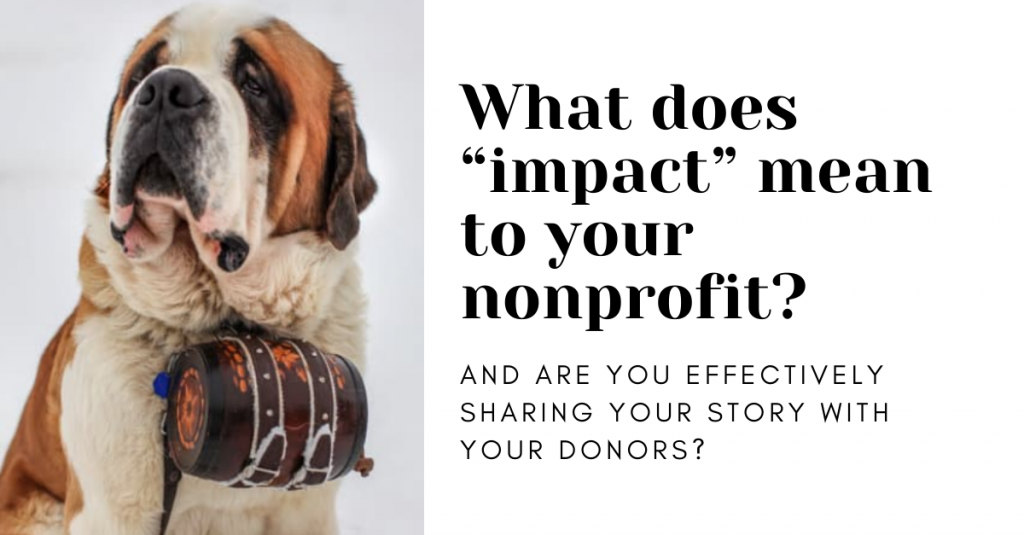
Did you know that the number one reason why high net worth donors give is to “make a difference?” It seems simple, right? Yet, many donors and prospects are not told, in a practical way, exactly how their gift has impacted your organization’s mission.
If you are like many fundraisers, you have metrics to fulfill and are laser-focused on your annual goals. These are great qualities and necessary for success. Yet when you are so focused on soliciting, you sometimes forget the purpose of why you asked in the first place! If you have a dedicated Donor Relations or Stewardship staff member or team, it can make the sharing of impact much easier. For those of you who are fundraising and stewarding donors, sharing philanthropic impact needs to be a central part of your job!
Why is this important?
Nonprofits’ average donor retention rate is just 45.5%. Interestingly, larger organizations are faring better with the retention of donors, likely because they have the resources to focus on donor relations and stewardship. But, if you are working for a small to midsize nonprofit, even though we know you are wearing many hats, stewarding donors and sharing impact needs to be higher on your list of priorities. As all of us in the philanthropy world know, retaining donors costs far less than acquiring new donors.
So, HOW do you share impact stories with your donors?
- I’m going to emphasize one word here: SPECIFIC. Tell real stories. If you work with children, consider highlighting a particular child who has been impacted by gifts. If you work for an animal rights organization, share specific examples of animals who have benefitted from donor funding. Focus on one person or one instance at a time. It’s a better way for donors to feel connected to that person or that situation rather than telling stories with broad strokes.
- Be sure to be CONCISE AND FOCUS on what matters most in your storytelling. You want to maintain the attention of your audience, mainly depending upon your format. So, get your point across with as few words as possible.
- Use VISUALS AND PHOTOS to tell your story. Images grab attention better than a block of text. Images can also often express emotion better than text and can convey a message more quickly.
- Include NUMBERS AND DATA when it helps tell your story. These are measurable results, and this can resonate with donors. Often, sharing impact through data can be very useful and adds validity to your storytelling. This doesn’t mean you are only sharing how much money was raised; it means sharing how many more meals you could serve to the homeless or how many new students received scholarship money because of donor generosity.
You must KNOW your donors to do any of this effectively.
Survey them to find out what are the stories that resonate the most. Profile some of your top donors to get an even more in-depth perspective.
Where are you telling these stories?
- Take advantage of SOCIAL MEDIA. Work to grow your following and figure out where your donors already are – are you getting more traction on Facebook or LinkedIn? With Social Media, visuals and photos are incredibly effective for telling stories and sharing quick impact moments.
- Use VIDEO when possible. Video allows you to show emotion and bring impact to life in a way that no other medium can offer. Personalize these videos when possible. Donors respond to a customized video from someone who has been impacted by their gifts. If it’s impossible to customize, merely showing donors through video how their gift has advanced your nonprofit’s mission is priceless.
- Your WEBSITE should provide an opportunity for you to tell stories and highlight impact. Make sure you have a page (or multiple pages) dedicated to this. Include video on this page as well.
- LETTERS/EMAILS/NOTES are all excellent ways to tell stories or highlight specific moments of impact. Your organization should consider a yearly or even quarterly newsletter that focuses on impact stories. Even when sending handwritten notes or letters, be sure to describe a small impact moment for that donor that resonates with them.
Go out there and share your stories!


About The Author: David Garamella
David is an accredited fundraiser with over 25 years of executive and consulting experience in philanthropy. Before forming The Giving Collaborative, he served as Philanthropy Counsel for the 150 affiliated Hospitals of the Planetree Alliance and Chief Development Officer for Griffin Health Services as well as Chief Philanthropy Officer for Rhode Island Hospital, the Academic Medical Center of Brown University. He has a proven record of developing new programs and highly successful fundraising teams for healthcare, higher education, and other not-for-profit organizations.
More posts by David Garamella